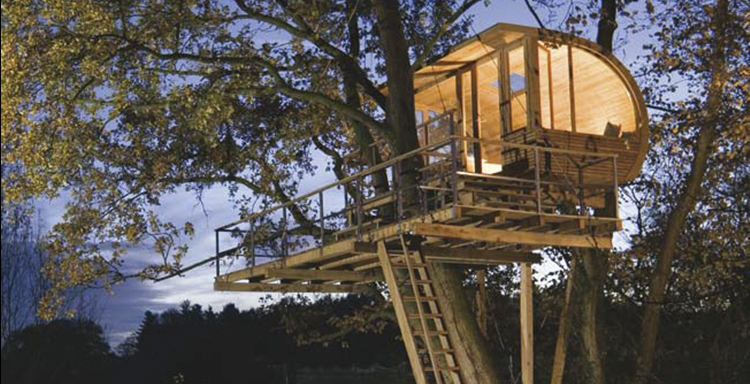What do Bart Simpson, David Beckham and the Roman Emperor Caligula have in common? Answer: they are all fully paid-up members of the treehouse fan-club.
Bart Simpson’s treehouse is his personal sanctuary where he can escape his manic family and plot fresh mischief in peace. Beckham spent a whopping A$50,000 to have a custom-built treehouse made for his three sons. Pliny the Elder recorded how Caligula ordered the construction of a dining room in a plane tree on an estate in Velitrae that was big enough to host novelty banquets high up amid the branches.
These treehouse aficionados are not alone. Formerly the preserve of small children, designer treehouses have become the latest celebrity must-have. Prince Charles, Sting, Jerry Hall and John Malkovich are just some of the famous faces who’ve become smitten with arboreal architecture.
As their status has shifted, treehouses have become considerably more elaborate. The days when these leafy dwellings were cobbled together from old planks and discarded junk are long gone. Increasingly treehouses are a form of grown-up indulgence that incorporates lots of mod cons. Designed by specialist architects they can now be fitted out with anything from kitchens to spa baths and plasma TVs.
At the top end of the scale, Alnwick Castle in the north of England has a treehouse in its grounds that cost A$7million. Commissioned by the Duchess of Northumberland as a fantasy playground for visiting children, the treehouse is the size of two Olympic swimming pools and required 280 tons of timber. Held up by 16 mature lime trees, the vast treehouse includes a 120seat restaurant and several turreted cottages linked by suspended walkways.
The evolution of treehouses has seen a new breed emerge that shuns folksy designs in favour of a modernist aesthetic.
At the forefront of this trend is Baumraum, a specialist treehouse firm from Germany started by Andreas Wenning, a professional architect. “ I didn’t have a treehouse when I was a child,” Wenning admits. “But I like trees and small experimental spaces.”
Baumraum, which literally translates to “tree room” in German, creates treehouses that blend in with their rustic surroundings while retaining a sci-fi edge. Wenning designs sleek cabins and capsules that incorporate smooth curves and oblique angles. The designs generally use the wood of larch and oak trees due to their weather-resistant properties, and beech, ash and elms make for reliable host trees. Wenning goes to great lengths to avoid harming the trees, usually using fabric belts and ropes instead of nails and screws. “We try to keep the damage to a tree down to a minimum,” he says. “We usually don’t cut the tree anywhere and work with tree experts who help us to find the best solution to connect the treehouse with the trees.”
Prince Charles, Sting, Jerry Hall and John Malkovich are just some of the famous faces who’ve become smitten with arboreal architecture.
Tourism close to nature is becoming more and more fashionable.
Baumraum’s innovative designs have quickly won an international following. Wenning’s six-strong team has already built treehouses in Germany, Austria, Hungary, Italy, Brazil and the USA. And they don’t come cheap. “For a construction abroad we start with a budget of $30,000,” Wenning says. Nevertheless business is booming. “Especially the commercial part is increasing,” he says. “People see that it’s a big value to be close to nature. And tourism close to nature is also becoming more and more fashionable.”
Designer treehouses appeal on two levels, satisfying our sense of childhood nostalgia while repackaging an old favourite in a sophisticated new form. Not suprisingly, Wenning has become an evangelist for living life out on a limb. “Treehouses give us a sense of adventure which is exciting,” he says. “But they also help to bring us closer to nature.”
www.baumraum.de
